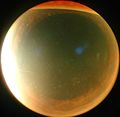Slit lamp
Slit lamp is a piece of equipment used primarily by ophthalmologists and optometrists for eye examination. It is an essential tool in the diagnosis of various eye diseases and conditions.
Description[edit]
A slit lamp is a high-intensity light source that can be focused to shine a thin sheet of light into the eye. It is used in conjunction with a biomicroscope. The lamp facilitates an examination of the anterior segment, or frontal structures and posterior segment of the human eye, which includes the eyelid, sclera, conjunctiva, iris, natural crystalline lens, and cornea. The binocular slit-lamp examination provides a stereoscopic magnified view of the eye structures in detail, enabling anatomical diagnoses to be made for a variety of eye conditions.
Uses[edit]
A slit lamp is used for the examination of the anterior and posterior segments of the human eye. It allows the doctor to thoroughly examine the patient's eye for any potential abnormalities or diseases. It is commonly used to detect conditions such as cataracts, macular degeneration, corneal ulcers, diabetic retinopathy, and glaucoma.
Procedure[edit]
During a slit lamp exam, the patient sits in a chair with the instrument placed in front. The patient rests their chin and forehead on a support to keep the head steady. The doctor then shines the slit lamp's light into the eye and examines the eye structures under magnification.
History[edit]
The slit lamp was first developed by Allvar Gullstrand, a Swedish ophthalmologist who won the Nobel Prize in Physiology or Medicine in 1911 for his work on the dioptrics of the eye. The design and functionality of the slit lamp have evolved over the years, with significant advancements in technology enhancing its diagnostic capabilities.
See also[edit]
|
|
|
-
Slit lamp
-
Slit lamp
-
Cataract in human eye
-
Diffuse Illumination
-
Focal illumination
-
Retro-illumination
-
Indirect lateral illumination
-
Sclerotic Scatter
-
Slit lamp fundoscopy
-
Slit lamp in use in Koforidua hospital, Ghana
-
Slit lamp in a clinic at Suhum, Ghana
Ad. Transform your life with W8MD's Budget GLP-1 injections from $75


W8MD offers a medical weight loss program to lose weight in Philadelphia. Our physician-supervised medical weight loss provides:
- Weight loss injections in NYC (generic and brand names):
- Zepbound / Mounjaro, Wegovy / Ozempic, Saxenda
- Most insurances accepted or discounted self-pay rates. We will obtain insurance prior authorizations if needed.
- Generic GLP1 weight loss injections from $75 for the starting dose.
- Also offer prescription weight loss medications including Phentermine, Qsymia, Diethylpropion, Contrave etc.
NYC weight loss doctor appointmentsNYC weight loss doctor appointments
Start your NYC weight loss journey today at our NYC medical weight loss and Philadelphia medical weight loss clinics.
- Call 718-946-5500 to lose weight in NYC or for medical weight loss in Philadelphia 215-676-2334.
- Tags:NYC medical weight loss, Philadelphia lose weight Zepbound NYC, Budget GLP1 weight loss injections, Wegovy Philadelphia, Wegovy NYC, Philadelphia medical weight loss, Brookly weight loss and Wegovy NYC
|
WikiMD's Wellness Encyclopedia |
| Let Food Be Thy Medicine Medicine Thy Food - Hippocrates |
Medical Disclaimer: WikiMD is not a substitute for professional medical advice. The information on WikiMD is provided as an information resource only, may be incorrect, outdated or misleading, and is not to be used or relied on for any diagnostic or treatment purposes. Please consult your health care provider before making any healthcare decisions or for guidance about a specific medical condition. WikiMD expressly disclaims responsibility, and shall have no liability, for any damages, loss, injury, or liability whatsoever suffered as a result of your reliance on the information contained in this site. By visiting this site you agree to the foregoing terms and conditions, which may from time to time be changed or supplemented by WikiMD. If you do not agree to the foregoing terms and conditions, you should not enter or use this site. See full disclaimer.
Credits:Most images are courtesy of Wikimedia commons, and templates, categories Wikipedia, licensed under CC BY SA or similar.
Translate this page: - East Asian
中文,
日本,
한국어,
South Asian
हिन्दी,
தமிழ்,
తెలుగు,
Urdu,
ಕನ್ನಡ,
Southeast Asian
Indonesian,
Vietnamese,
Thai,
မြန်မာဘာသာ,
বাংলা
European
español,
Deutsch,
français,
Greek,
português do Brasil,
polski,
română,
русский,
Nederlands,
norsk,
svenska,
suomi,
Italian
Middle Eastern & African
عربى,
Turkish,
Persian,
Hebrew,
Afrikaans,
isiZulu,
Kiswahili,
Other
Bulgarian,
Hungarian,
Czech,
Swedish,
മലയാളം,
मराठी,
ਪੰਜਾਬੀ,
ગુજરાતી,
Portuguese,
Ukrainian












